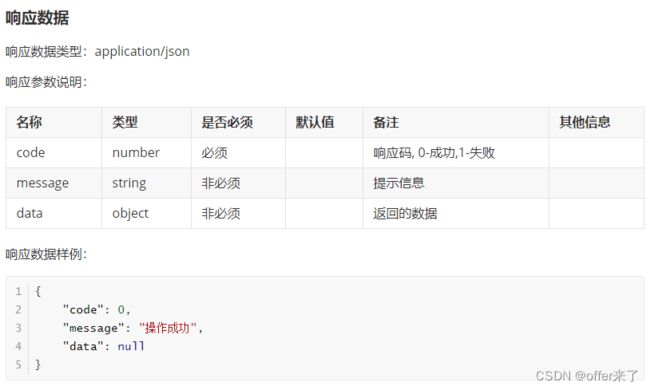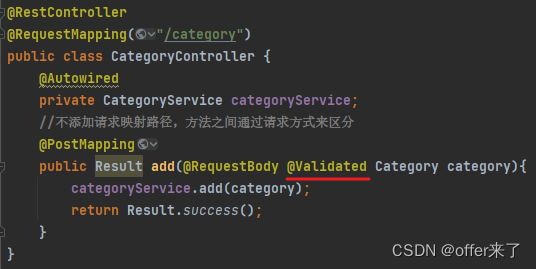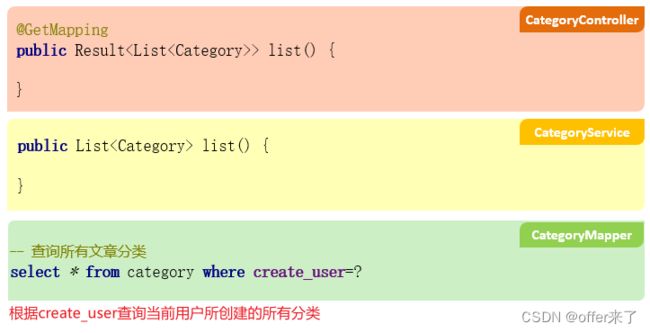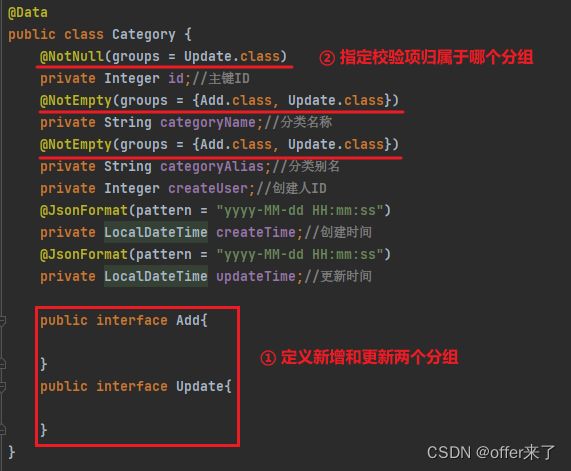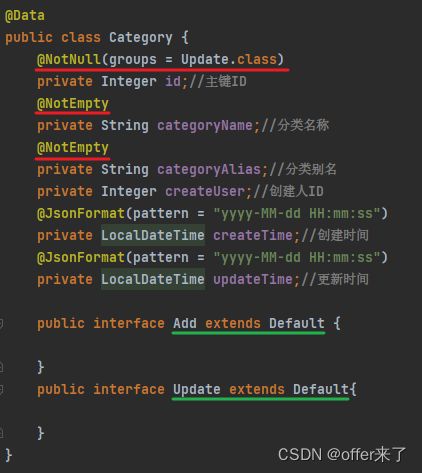3.【SpringBoot3】文章分类接口开发
序言
在文章分类模块,有以下接口需要开发:
- 新增文章分类
- 文章分类列表
- 获取文章分类详情
- 更新文章分类
- 删除文章分类
数据库表字段和实体类属性:
在数据库表中,create_user 来自于 user 表中的主键 id,是用来记录当前文章分类是哪个用户创建的,有了这个字段,将来用户在查看、修改、删除时就只能操作自己创建的分类。
1. 新增文章分类
需求分析
当用户点击左侧“文章分类”时,会在页面主区域展示文章分类相关内容,页面右上角有“添加分类”按钮,点击该按钮弹出添加分类的弹窗,用户需要输入“分类名称”、“分类别名”,最后点击“确认”以访问后台接口来完成分类的添加。
接口文档
1.1 新增文章分类基本代码编写
接口实现思路
CategoryController 中添加一个用于新增文章分类的 add() 方法:该方法上不添加请求映射路径,因为会在 CategoryController 上添加 “/category”,且方法之间会通过请求方式来区分;add() 方法内部调用 Service 层新增文章分类的方法;Mapper 层编写 SQL 来新增文章分类。
代码实现
完成代码编写之前,首先新建所需的包、类或接口
(1) Controller
@RestController
@RequestMapping("/category")
public class CategoryController {
@Autowired
private CategoryService categoryService;
//不添加请求映射路径,方法之间通过请求方式来区分
@PostMapping
public Result add(@RequestBody Category category){
categoryService.add(category);
return Result.success();
}
}
(2) Service
//Service接口
public interface CategoryService {
//新增文章分类
void add(Category category);
}
//Service实现类
@Service
public class CategoryServiceImpl implements CategoryService {
@Autowired
private CategoryMapper categoryMapper;
@Override
public void add(Category category) {
//完善属性
//创建时间、更新时间
category.setCreateTime(LocalDateTime.now());
category.setUpdateTime(LocalDateTime.now());
//创建人id
Map<String, Object> map = ThreadLocalUtil.get();
Integer id = (Integer) map.get("id");
category.setCreateUser(id);
categoryMapper.add(category);
}
}
(3) Mapper
@Mapper
public interface CategoryMapper {
//新增文章分类
//不用插入id,数据库会自动生成
@Insert("insert into category(category_name, category_alias, create_user, create_time, update_time)" +
" values(#{categoryName}, #{categoryAlias}, #{createUser}, #{createTime}, #{updateTime})")
void add(Category category);
}
postman 测试:
首先,在文章分类这个集合下配置最新的 token 令牌:
1.2 新增文章分类参数校验
在上面的代码基础上,如果不填写 categoryName,postman 测试时会报以下错误:
这里是 Mapper 层报的错误,说明请求已经通过了 Controller 和 Service 层。实际上,如果用户没有传 categoryName,应该在 Controller 层校验时抛出异常,而不是任由请求继续。
接口文档中指出 categoryName、categoryAlias 两个参数不能为空,因此需要对这两个参数进行校验。接口文档中对于这两个参数的说明:
参照上篇博客【用户模块接口开发】的 4.2 节借助 Validation 完成参数校验:要求字符串类型非空,在成员变量上添加 @NotEmpty 注解即可,另外为了使该注解生效,还要在对应方法参数的前面添加 @Validated 注解。
postman 测试:
2. 展示文章分类列表
需求分析
当用户点击左侧菜单栏中的“文章分类”时,右侧页面主区域会展示出当前用户创建的所有分类,展示这些数据需要调用获取文章分类列表接口来获取。
接口文档:
接口实现思路
在 CategoryController 中添加方法 list()。因为展示文章分类列表是查询操作,所以有主体数据响应给浏览器。在接口文档中可以看到,主体数据是一个数组,数组中有多个对象。在 Java 中,数组可以声明为集合 List,结合本节的场景,该 List 中应该有多个 Category 对象代表多个文章分类。所以 Result 类中 data 的类型是 List。
方法内部调用 Service 层,Mapper 层执行响应 SQL。
代码实现
CategoryController 中:
//文章分类列表查询
@GetMapping
//展示文章分类列表是查询操作,所以有主体数据响应给浏览器
//在接口文档中可以看到,主体数据是一个数组,数组中有多个对象
public Result<List<Category>> list(){
List<Category> cs = categoryService.list();
return Result.success(cs);
}
CategoryService 中:
//Service接口
//文章分类列表查询
List<Category> list();
//Service实现类
//文章分类列表查询
@Override
public List<Category> list() {
Map<String, Object> map = ThreadLocalUtil.get();
Integer userId = (Integer) map.get("id");
return categoryMapper.list(userId);
}
CategoryMapper 中:
//文章分类列表查询
@Select("select * from category where create_user=#{userId}")
List<Category> list(Integer userId);
postman 测试:
测试成功。但是,现在有个问题,后台返回的数据中,createTime 和 updateTime 的格式与接口文档中的响应数据样例不同。
实体类对象转换成 json 字符串时,如何指定日期的格式呢?需要借助 @JsonFormat 注解。
此时,响应数据中的日期格式就符合要求了:
3. 获取文章分类详情
需求分析
在分类列表中,当用户点击某一条分类后面的编辑按钮后,会弹出一个弹窗,弹窗中展示了被点击分类的详细信息,包括分类名称和分类别名。这样,用户就可以在原有信息的基础上进行修改。如果想要展示被点击分类的详细信息,就要访问“获取文章分类详情”接口,拿到数据后再去展示。
接口实现思路
CategoeyController 中声明 detail() 方法用于获取文章分类详情。从接口文档可知,响应数据中的 data 是一个 Category 对象,所以 detail() 方法返回值是 Result
方法内部调用 Service 层的方法完成查询,Mapper 层执行相应的 SQL,根据分类的 id 进行查询。
CategoryController 中:
//获取文章分类详情
@GetMapping("/detail")
public Result<Category> detail(Integer id){
//根据点击的文章分类的id进行查询
Category category = categoryService.findById(id);
return Result.success(category);
}
CategoryService 中:
//根据id查询文章分类信息
Category findById(Integer id);
//根据id查询文章分类信息
@Override
public Category findById(Integer id) {
Category category = categoryMapper.findById(id);
return category;
}
CategoryMapper 中:
//根据id查询文章分类信息
@Select("select * from category where id=#{id}")
Category findById(Integer id);
postman 测试:
4. 更新文章分类
需求分析
接口文档
4.1 更新文章分类基本代码编写
接口实现思路
Controller 层,根据接口文档,需要对 Category 的属性 id、categoryName、categoryAlias 进行参数校验,所以要在参数上添加 @Validated。方法内部调用 Service 层更新头像的方法,Mapper 层编写 SQL 来更新头像。
CategoryController 中:
//更新文章分类
@PutMapping
public Result update(@RequestBody @Validated Category category){
categoryService.update(category);
return Result.success();
}
CategoryService 中:
//更新文章分类
void update(Category category);
//更新文章分类
@Override
public void update(Category category) {
category.setUpdateTime(LocalDateTime.now());
categoryMapper.update(category);
}
CategoryMapper 中:
//更新文章分类
@Update("update category set category_name=#{categoryName}, " +
"category_alias=#{categoryAlias}, update_time=#{updateTime} " +
"where id=#{id}")
void update(Category category);
根据接口文档,需要对 id、categoryName、categoryAlias 进行参数校验:
postman 测试:
4.2 分组校验
完成了前面模块的功能,程序中实际存在一个 bug。在实现“更新文章分类”功能时,我们在 Category 这个实体类的 id 属性上添加了 @NotNull 注解,这就意味着前端在传递数据给添加了 @Validated 注解的 Category 实体参数时,id 不能为空。但是,“新增文章分类”时,前端只需填写 categoryName 和 categoryAlias,无需向后台传递 id(是数据库自动增长的)。因此,虽然“更新文章分类”功能是正常的,但是“新增文章分类”功能却出问题了。
只要能将校验分组,新增有一组规则,更新有一组规则,然后在新增接口中使用新增校验规则,更新接口中使用更新校验规则,该问题就能解决。那么,具体该如何实现呢?
- Validation 中表示分组需要通过接口来表示,定义一个接口就代表一个分组,现在有添加和更新两组,所以首先要在 Category 类中定义两个内部接口;
- 定义校验项时,指定该校验项的归属分组(groups,类型是数组),可以给同一个校验项指定多个分组;
- 校验时指定要校验的分组。
postman 测试,新增和更新功能都正常:
当校验分组的组数过多时,挨个向每个注解上的 groups 中添加其隶属的分组是比较麻烦的。此时,可以借助 Validation 的默认分组进行优化。
Validation 的默认分组遵循以下规则:
- 如果某个校验项没有指定分组,默认属于 Default 分组;
- 分组之间可以继承,当 A extends B 时,A 就拥有了 B 中所有的校验项。
因此,代码可以优化如下:
未指定分组的 categoryName 和 categoryAlias 属性属于 Default 分组。既然 Add 分组和 Update 分组都继承了 Default 分组,那么就都包含这两个属性的校验;除此之外,Update 分组还拥有对 id 的校验。因此,将 Add 分组和 Update 分组添加到相应的 @Validated 注解上能够发挥预期作用。
5. 删除文章分类
接口文档
(1) Controller
//根据id删除文章分类
@DeleteMapping
public Result delete(Integer id){
categoryService.delete(id);
return Result.success();
}
(2) Service
//根据id删除文章分类
void delete(Integer id);
//根据id删除文章分类
@Override
public void delete(Integer id) {
categoryMapper.delete(id);
}
(3) Mapper
//根据id删除文章分类
@Delete("delete from category where id=#{id}")
void delete(Integer id);
postman 测试:



